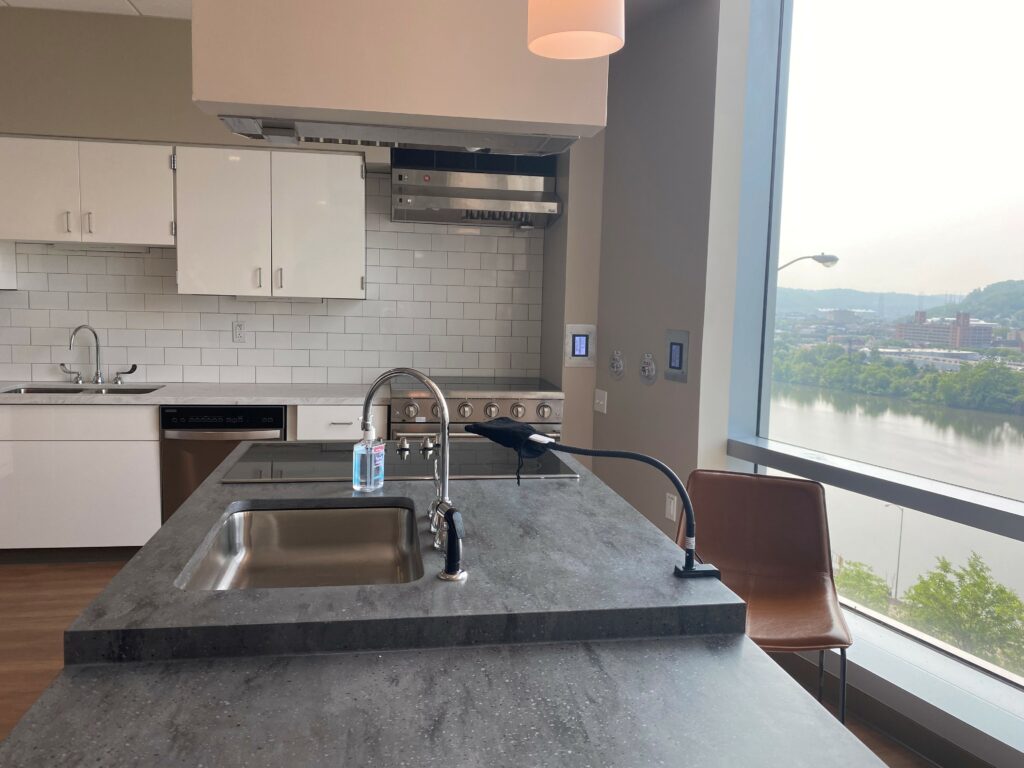Patients with low vision are getting a much more holistic experience at the new Vision Institute at UPMC Mercy Pavilion. In the old building, they received more of a clinical assessment. Now they get as close to a real-world assessment as possible.
Holly Stants, MS, OTR/L, SCLV, CLVT, an occupational therapist specializing in low vision occupational therapy, used to take her patients down to the lobby in the Eye Center to see a beautiful set of paintings of famous people in Pittsburgh who contributed to science. This was a way to allow the patient to experience things.
The new building, however, takes this to a whole new level. A life skills apartment has a kitchen, living room, bedroom, and laundry room where patients can simulate activities as if they were at home.
“They can actually engage in the activity instead of us trying to show them some things on the counter and then hope they can translate that at home,” Stants said. “As a clinician working in low vision, being able to have that set up is priceless.”
The Vision Institute also has an outdoor garden, where patients can be walked through pathways that have different landscapes. Stants uses it for patients trying glare filters.
In addition to having more space, the new building houses new technology. One such device is Dynavision, a cognitive training device that combines eye-hand coordination, peripheral vision training, and brain processing. Certain sections can be programmed, and tasks can be recorded.
A second device is the Bioness Integrative Therapy System (BITS), a flat screen that helps with visual skills training.
There is also a new head mounted low vision device for patients to work on their vision. A technology lab with computers has adaptive software for patients, enlarging things or activating text-to-speech.
“Everything really is the newest and latest technology that’s out there to try to maximize people’s ability to see or perform better,” said Dr. William Smith, OD, Director of the Low Vision Service.
Soon to come is a driving simulator, which will assess people’s ability to drive. Clinicians can make modifications as needed, or even conduct research.
Patients have commented on the ease of getting in and around the new building. Dr. Smith pointed out that if patients feel more comfortable from the start, it allows for a smoother transition to treatment or rehabilitation. “The patient really feels part of the building or part of the whole, rather than just a separate entity,” he said.
A hallmark of the Vision Institute is collaboration – whether inside or outside the building. Efforts have been made to work with the Blind & Vision Rehabilitation Services of Pittsburgh, which is just down the street. Having UPMC Mercy’s Rehabilitation Institute next door means patients there can have access to low vision services, and vice versa.
“We have great teams on both sides,” Stants said. “Everybody’s working together. This is going to be a model for the future, where it’s just about meeting the patient where they are.”
Stants and Dr. Smith are working with people like Beth Matcho, PT, DPT, Regional Director, UPMC Rehabilitation Institute, to train occupational therapists as low vision champions. The idea is that the low vision champion staff can identify patients who have low vision and then provide resources, simple interventions, and continuity of care, including recommending low vision outpatient services.
The team has trained nine people this year and will train at least another nine this year. They are working with acute and skilled nursing within the UPMC system as well.
The Vision Institute is truly unique. As Smith said, “There are very few places like this in the country. We’ll be able to really provide the best care that we can for our patients.”
